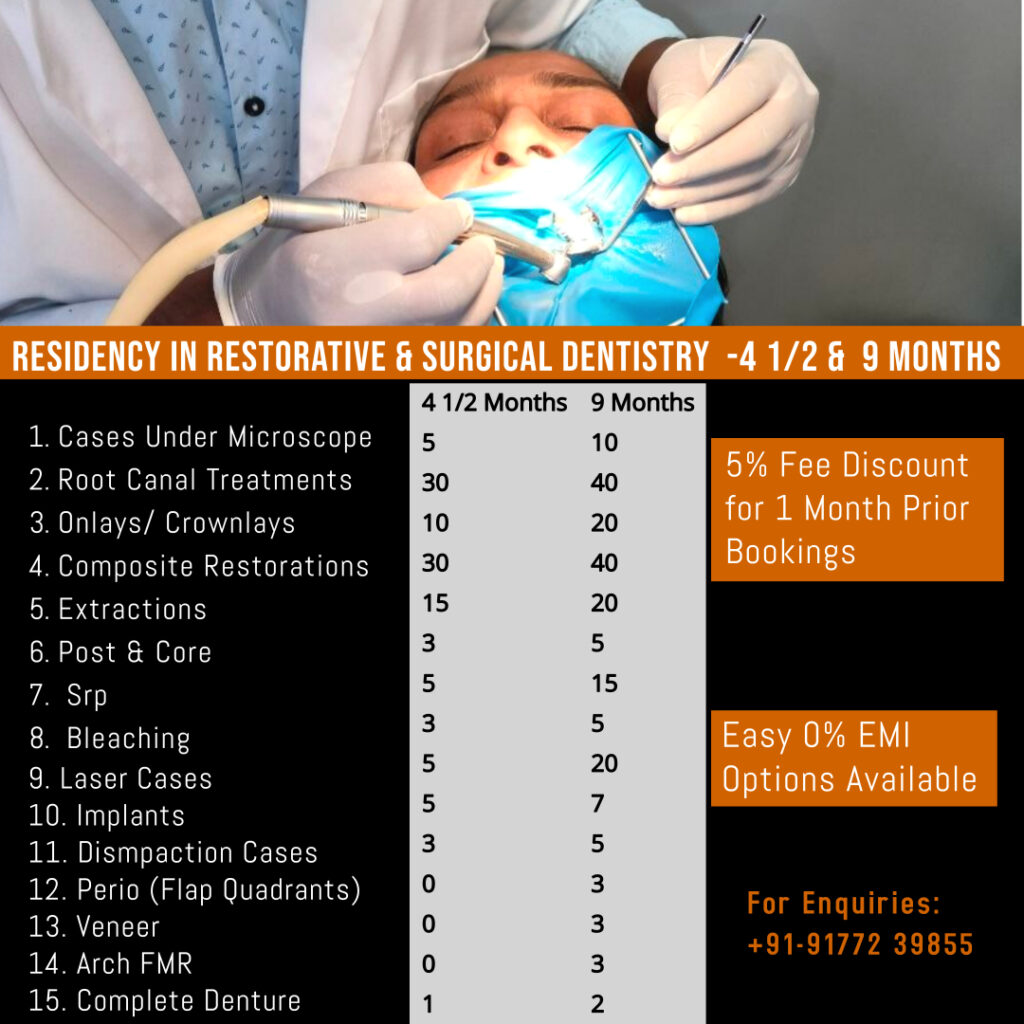This is a one of its kind course in the Country specially designed for dentists who really want to excel in multiple advance procedures including surgeries in different specialties. In addition, the graduates are expected to be pioneers as they shall be learning by doing Global Best Practice!!

Introduction
Implants & Patients
Placing Dental Implants
Restoring Implants
Post Surgery Maintenance
Radiography
Implant Maintenance
Interrupted single sling suture demonstration
Sr No | Case Type | Residency: 5 Months | Residency: 9 Month |
1 | Cases Under Microscope | 5 | 10 |
2 | RCT’s (incl pulpectomies) | 30 | 40 |
3 | Onlays/Crownlays | 10 | 20 |
4 | Composite Restorations | 30 | 40 |
5 | Extractions | 15 | 20 |
6 | Post and Core | 3 | 5 |
7 | SRP | 5 | 15 |
8 | Bleaching | 3 | 5 |
Sr No | Case Type | Residency: 5 Months | Residency: 9 Months |
1 | Complete Denture | 1 | 2 |
2 | Laser | 5 | 20 |
3 | Disimpaction | 3 | 5 |
4 | Implant | 5 | 7 |
5 | Ortho | 0 | 3+5 |
6 | Flap Surgeries* | 0 | 3 |
7 | Veneer | 0 | 3 |
8 | FMR | 0 | 3 |
Sr No | Offering | Fees |
1 | Residency 5 Months | ₹ 2,60,000 |
2 | Residency 9 Months | ₹ 3,60,000 |
Bank Account Details:
Account Name: Ace Dental
AC No: 50455390170
IFSC Code : IDIB000V541
Bank Name: Indian Bank
Branch : Chikkadpally
UPI Id:
11204864496@okbizaxis
Razorpay Payment Link
https://pages.razorpay.com/pl_JGOkjMXXxjxps7/view
Note: The academy does not accept cash for fee payments.
Contact:
Course Director +91-90328 29848
Admission Department: +91-91772 39855
Students need to have a valid Local Dental Council registration, with a valid BDS or MDS Degree from a recognized Dental College.
Yes, Course Completion will be provided to all Students who successfully complete the course quota. A experience letter shall also be provided which shall be based on quota completed under proper protocols and timely submission of case documentation.
Documentation involves uploading /Sharing pre-op, mid-op and post op photo of the respective course Quota on Ace Institute Telegram Group with relevant clinical points of significance in a timely manner.
Case Documentation is essential for:
1) Self Evaluation
2) Mentor Evaluation
3) Statutory Medico-Legal Requirement
4) Portfolio Preparing a comprehensive a portfolio for Future Job Opportunities
5) Research & Study
6) Unified Case Gallery: Good clinical photographs for pre-op, mid-treatment and post-treatment evaluation, follow-up, research, publication, seminars, conferencing, as well as patient canvassing and marketing of skills.
7) Scholarships & Certificate: Case documentation is mandatory to receive final Certificate of training & Scholarships
Refer the material requirement section above.
We can refer you to nearby hostels where our existing students stay.
Yes, we provide easy payment options with zero percent interest in association with our partner company: Northern arch Capital.
Other option being payment via post dated cheques. You may contact our admission department for the same.
Yes, kindly contact our Admission Department for more info.
Welcome to Ace Institute of Dentistry! We offer short-term and long-term workshops and clinical courses for dentists. We operate on three core values: Ethics, learning by doing and Best Practice Protocols aligned with international standards. we offer a range of courses on Endodontics, Implantology, Exodontia, lasers and more. Our hands-on approach ensures ample patient exposure empowering dentists to excel in their practice.
Ace Institute Of Dentistry, Kishanbagh, Hyderabad, Telangana, India